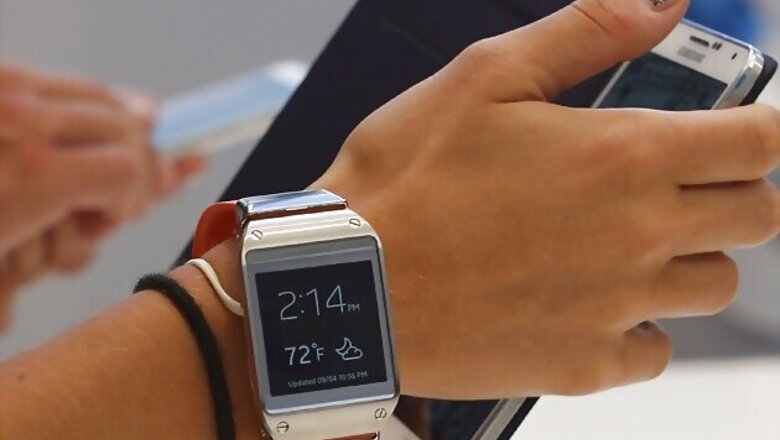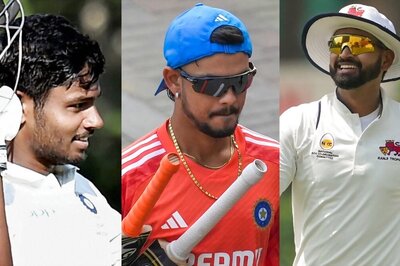
views
Singapore: The smartwatch could be as revolutionary as the smartphone - an intelligent device on our wrist that connects our bodies to data and us to the world - but only a handful of companies have the heft and vision to be able to pull it off.
It's not through lack of trying. Watchmakers and others have been adding calculators, calendars and wireless data connections to wrist-straps for at least 30 years.
Samsung Electronics Co Ltd is having another go on Wednesday, when it launches the Galaxy Gear in Berlin, but a source familiar with the matter said that the smartwatch device would be no game changer - more of a fashion accessory than an effort to redefine the genre.
Sony Corp is also launching a modest update of its Android-compatible SmartWatch, while heavyweights Apple Inc and Google Inc have shown tentative signs of interest in developing such technology.
The market potential, cheerleaders say, is vast. Leveraging advances in voice technology, biometrics, communications, cloud storage and power consumption, smartwatches and other wearable devices could be a $50 billion market by 2017, according to Credit Suisse.
"Look at the way we experience mobile communication today - this is not the end point," said Andrew Sheehy, chief analyst at British-based consultancy Generator Research, pointing to the awkwardness with which most of us clasp the handset to our ear, remove it from our pockets to read messages, or tap in appointments and emails.
"If you look at the phone today, it's important to ask: is this as good as it gets?"
Wearable devices such as smartwatches or digital eyewear, the argument goes, could take over many of the more cumbersome functions of a smartphone while also adding functions we can so far only dream of.
By tapping into sensors around the body, on objects and in other devices, they could offer what Plantronics, a headset maker, calls "contextual intelligence", harvesting data to create "a highly personalized experience in real-time", according to Joe Burton, the company's CTO.
Advances in technology
Driving this optimism are advances in technology, and a more sophisticated audience already familiar with smartphones, apps, and wireless communication protocols such as Bluetooth.
The prices and size of sensors have fallen rapidly - making them a feature of many smartphones. Samsung's Galaxy S4 has nine, according to a report on wearable technology by Credit Suisse.
An addition to Bluetooth, for example, uses much less energy and can push and pull data to a watch via the mobile phone, says Paul Williamson of CSR plc, a maker of such so-called Bluetooth Smart chips.
With the technology now integrated into devices running the latest versions of Apple's iOS and Google's Android operating systems, "smartwatches can render data from any of the applications that are running on your smartphone", Williamson said.
Smartwatches like the Magellan Echo, for example, can stream data wirelessly from a range of third party fitness apps on a smartphone, without requiring frequent recharges.
Tim Ensor, head of connected devices at British-based Cambridge Consultants, which advises companies and develops new technologies, called the adoption of Bluetooth Smart "a real game-changer".
But so far wearables have remained a niche for early adopters, such as fans of Pebble Technology's crowd-funded smartwatch, which has sold 100,000 units since its launch earlier this year, or health and fitness enthusiasts embracing Nike's Fuelband or Under Armour's FitBit.
And therein lies the rub, says Generator Research's Sheehy. Most of these players have either thought too small, or lack the heft to be able to break into the mainstream.
That not only means having capital and resources, but being able to build on existing expertise in hardware, software, cloud and processing data.
"This is tough technology," he says. "The number of companies who can do this are very few and far between."
Hurdles remain
First there are remaining technological hurdles, such as powering the devices. Batteries will need to be 5-10 times smaller than those in smartphones, says Cosmin Laslau, mobile energy analyst at Lux Research, requiring innovation in cell materials such as silicon anodes and packaging - such as Apple's work on flexible batteries.
Then there is a need for better displays. Both Apple and Samsung have been working on curved glass - Samsung is investing more than $6 billion on displays this year alone, and is planning to launch a curved mobile device later this year, according to a source familiar with the matter.
There's also the fact that wearing a device is not quite the same as carrying one.
For one thing it has to be stylish, says Gartner research director Angela McIntyre.
Filip Technologies spent three years working on a watch to make it acceptable for the kids who would wear it and their parents who would use it to track and communicate with their offspring via a smartphone.
"Consumers need to develop a more personal relationship with a wearable computing device than they would otherwise with a handheld device," said CEO Jonathan Peachey, who joined the company in July.
Key to this is the interface, says Thad Starner, Professor of Computing at Georgia Institute of Technology, whose pioneering work with wearable computers led to him be a technical lead for Google Glass.
Developing a mobile interface for wristwatches and heads-up displays requires lots of experimentation, he says. The best way, he adds, is to build "living laboratories" where more and more people use them in everyday life.
"The most important thing, right now, is to reduce the time between the user's intention to perform a task and the user's action to complete that task."
His other projects point to the possibilities: a contraption that lets him answer students' text messages by voice while wandering across campus and a gesture interface that understands sign language.
Do I need it?
But even if those hurdles are overcome, just how useful is a wearable device going to be? "Finding a role or a use for wearable electronics is the central question facing the industry today," says Mykola Golovko, an analyst at Euromonitor.
Right now the most appealing prospects are as a "slave" to the smartphone or tablet, where the wearable devices collects data from the user's body or environment and relays it to the smartphone. The smartphone acts as a gateway to the Internet to process this information and merge it with other data before feeding it back to the device.
"In this world the role of the smartwatch is not to replace the phone but to keep the data feed going and make it even more accessible," says Rob Milner, technical leader of smart systems at Cambridge Consultants.
But this is not going to be everyone's cup of tea.
"The multi-sensor combo packages and low-power wireless chips are available," says Shane Walker, an analyst at IHS, "now the data created from this pairing needs to be made compelling and useful."
Cracking the nut
Which means that whoever cracks the nut of a mass market wearable device is less likely to be a pure hardware maker than a broader-based company.
"You can call me a smartwatch skeptic," says Sarah Rotman Epps, an analyst at Forrester. "I don't see that any vendor, with the possible exception of Apple, can make smartwatches a mainstream success."
Speculation aside, Apple has kept its cards close to its chest. CEO Tim Cook has called the wrist "interesting" and Apple has registered the trademark iWatch in Japan. Several Apple patents point to wrist-worn devices.
And Google has staked a claim in wearables with its Google Glass, spectacles that include a small visual display. It bought start-up WIMM Labs, which had launched a smartwatch in 2011, and has demonstrated the power of contextual information with Google Now, which mines users' emails, location and other data to provide a personalized stream of data.
Other possible players, says Generation Research's Sheehy, include Microsoft Corp, Yahoo Inc.
"If Samsung or Google succeeded at this and Apple failed at this level, it would really be a handing over of the baton," he said.
If the Galaxy Gear is the first salvo, Apple has little to fear. After two earlier wrist-phone flops in 1999 and 2009, Samsung is taking a cautious approach with its latest version of the smartwatch, according to the source familiar with Samsung's thinking.
"Samsung is trying to say that it is not following but jumping into it ahead of its key rival, i.e. Apple," he said. "They are simply dipping their toes into the market as they don't want to take big risks with a costly bet on the new unproven category yet."

















Comments
0 comment